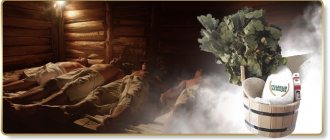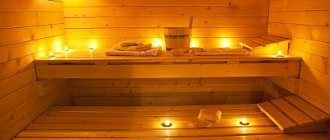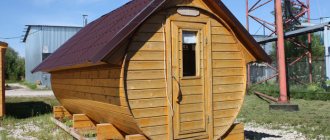Bathhouse. Even when it’s hot outside, it’s nice to think about it. Because it relaxes and gives strength. And in the chilly autumn - beauty. And in winter. But not everyone wants to jump into the snow. We need to prepare. Otherwise, you can harm yourself.
The bathhouse in Rus' has always been a special place. Both saving and healing. Births took place there. The bathhouse helped our ancestors keep themselves clean. Let us remember the king of France, whose name was Louis. And he was the fourteenth in a row. They say the man didn’t wash at all—he just poured perfume on himself.
I won’t figure out now whether this is true or a beautiful fiction with a scent. Not in this case. The fact is that Rus' has always loved the bathhouse. And this means that they didn’t go dirty.
In Europe there was every chance to join the culture. After all, the bathhouse is not a Russian invention. But somehow everything came to nothing for them. That's why there is no European bathhouse. There is a Finnish one. But this is a completely different matter.
Okay, I'll stop the racing thoughts. Let's move on to bath traditions.
Visiting order
We went to the bathhouse in a strict order. At first the men went there. Then – women. Now they would say that this is real discrimination. In Rus' this was the order of things. Patriarchal society, nothing can be done. I think that the women did nothing to change the order of visiting the bathhouse.
In general, there was nothing surprising in this. Another thing is more interesting: you couldn’t go to the bathhouse third. It was believed that she was busy with the bannik.
According to legend, if someone dared to go to the bathhouse for the third time, then the spirit of the steam room would become very angry and could release fumes into the steam room, or they could throw boiling water over them.
Whether there were such cases, I don’t know. Maybe. In any case, all the incidents that happened in the baths were probably attributed to the bannik. They say he punished people for not following traditions. There’s no point in angering grandpa!
Bath day
Life outside the city 0
0
Our very distant ancestors did not suffer from cleanliness - the conditions in the caves were not the same. However, one day it became clear to them that the washing process is not only about cleanliness, but also about health. In the bathhouses they not only washed themselves, but also made acquaintances, arranged brides and grooms’ viewings, gave birth, received treatment, saw them off on their last journey, resolved important issues, communicated, performed magic... And it so happened that the bathhouse became an indispensable attribute of civilization. In different parts of the inhabited earth, their own bathing traditions arose, which, in general, turned out to be very similar to each other. Maybe because the bathhouse is a place where we are all naked, and this is what unites us?
Ancient invention
Archaeologists could not identify the piles of stones found in Paleolithic sites. Then they agreed that these were the very first baths on the planet. This opinion was also reached because archaic tribes that have survived to this day in their primitiveness - the same American Indians - used and continue to use similar “structures” for ritual ablutions. They assemble a structure of branches and twigs over the stones, cover them with skins, force steam inside, splashing water with extracts of hallucinogenic herbs and mushrooms on the hot stones, and perform shamanism on the sly.
Over the course of thousands of years, the bathhouse has stepped far forward from a pile of stones. It was first improved by nomads. The Scythians, according to the description of the historian Herodotus, erected a kind of yurt made of felt over a pit with stones, and then scattered hemp seeds over the hot stones. Nearby stood a huge cauldron of water, into which hot stones were thrown to generate steam. Interestingly, according to the historian’s description, the Scythians had enough steam - they never washed their bodies with water.
The ancient Egyptians were much cleaner. The priests, for example, washed themselves four times a day. It is clear that with such habits it was necessary to erect real washing facilities; they were clay pools or stone baths in which cold water splashed. It was chilly to wash, and therefore it was the Egyptians who came up with something that the Greeks, Romans, Byzantines and Arabs later adopted from them: the steam room. In this room, stone loungers were heated by the fire of the hearth, which was located on the floor below, and warm air was supplied through openings. Here they washed themselves with beeswax, the bathhouse attendants gave healing rubs to the guests, and sometimes next door there was a special treatment room where simple operations were performed.
It is believed that massage was introduced into the steam room by the Indians. Moreover, it was done by two bath attendants and servants at once. The session of kneading the whole body lasted about an hour, and it was as if the person was being born again. But the highlight of the ancient Chinese baths were all kinds of healing baths and herbal compresses.
Golden age
Rumor has it that the father of medicine, Hippocrates, prescribed bath procedures for half of his patients (even those who were hopeless). The name of the Laconicum baths of Ancient Greece was given by the Spartans: the Lacedaemonians, strong in body and spirit, attached great importance to bath procedures and knew how to build “washing rooms” with high quality. These were round houses with a fireplace and a bath inside. There was no drainage: after washing, the water from the container was simply scooped out and refilled. After the visit of Alexander the Great to the borders of the Oikumene, they began to build baths following the example of the Egyptian ones, with heated floors and a prototype of water supply. Although public baths were available to all residents of the peninsula without exception, the rich preferred to retire to personal ones, lined with precious stones and precious metals.
The ancient Romans were even more zealous in designing their baths. After all, sometimes they spent days on end in the bathhouse, holding meetings here, luxurious feasts, poetry readings, theatrical performances, and physical education classes... Every emperor considered it his duty to first build a bathhouse. Architects tried to outdo each other in creating luxurious palaces intended exclusively for ablutions: enfilades of columns, waterfalls, fountains, sculptures, flowering courtyards. The walls were decorated with frescoes and mosaics, and the basins and jugs were made of silver and gold. The thermal baths were multifunctional in design: there were rooms with dry heat and wet steam (temperatures reached 85C), a shower system, pools with warm and cold water for contrast dives, and baths. Here doctors received treatment and servants massaged, barbers shaved and removed calluses. On private property nearby there was a park for walking and a playground for games and gymnastics. The Romans thought out a perfect water supply system: it flowed through aqueducts in huge quantities, filled the pipes, flowed down the walls and then went into the sewer. And the Egyptian central heating system, the hypocaust, improved by the Romans, was responsible for heating the floors and walls.
Unwashed Europe
Until the Roman Empire collapsed, the population was pure only where a Roman had set foot. In the distant conquered lands, the imperial troops first built baths, and the ruins of hypocausts are found even in cold Britain (on the site of one of the Roman bath complexes, by the way, the famous English resort of Bath appeared). But then the baths were turned into temples, and thermal traditions were forgotten. Medieval Europe washed at best twice a year - at Easter and Christmas. Public bathing complexes appeared in European cities only in the 9th century. And they were not as luxurious as Roman or Byzantine ones: visitors steamed, lying on benches, washed in wooden vats. The bathhouse was more of an establishment like a first aid station combined with a hairdresser. Hildegard of Bingen, a nun and saint, known for her works on folk medicine, wrote that in case of illness, one should drink decoctions of medicinal herbs in the bathhouse and splash the same decoctions on hot stones for inhalation. They also went to the bathhouse to shave or get a haircut, to do bloodletting or cut off calluses - the bathhouse attendants were also barbers, and also managed to earn extra money as firefighters (they always had water and tubs).
Baths often coexisted with brothels, and this is partly why they finally fell into disrepair by the 16th century. Then the opinion reigned that washing was very harmful to health. It is believed that the “sponsors” of this opinion were the priests, who considered the baths a hotbed of debauchery and venereal diseases. Europeans continued to unravel the consequences of this belief for several centuries, when the population of entire cities was wiped out by plague, cholera, scabies and prickly heat. They feared water like fire! They say that even the radiant Sun King Louis XIV washed himself only twice in his life.
It was only during the Renaissance that ideas that we would now call spa culture were revived. Baths are again held in high esteem, all over Europe people go to the water, new thermal springs are opening (including in Spa), and entire resorts are being built. This is more about a luxurious lifestyle than the needs of routine hygiene. The healing properties of the bath and other types of water procedures were “discovered” only in the 19th century.
Oriental delights
Byzantium and the Muslim East continued to improve baths even after the collapse of the Roman Empire. But in Asia Minor they ceased to be the center of public life: in Constantinople, many baths were converted into temples, and people washed in squalid buildings that were heated in black. But it was from Byzantium that the Arabs brought the idea of Roman baths as a way of life to the Arabian Peninsula. Here it took root: frequent ablutions, 5 times a day, are prescribed by Islam. Therefore, the hammam - as the bathhouse began to be called in these places - not only took root here, but again regained its social significance. And the construction of a hammam was equated to the construction of a mosque and was considered a godly deed, allowing “to wash away all sins.” And the Arabs went to the bathhouse almost as often as to the mosque.
The steam in the eastern baths is moist, so the high temperature here is not very felt. Meanwhile, there are several hammam rooms, and if in the first it is only 35 degrees, then by the end of the journey from room to room you can find yourself in heat of almost 100C with one hundred percent humidity. It is very easy to warm up in the hammam, so the procedure ends with a cold shower, which immediately gives you vigor. And, by the way, cold dousing is an innovation of the Arabs, who, although they learned to steam with taste in their time, never stopped dousing themselves with cold water. The fact is that religion does not allow Muslims to wash by immersing themselves in a closed container of water - it’s the same as washing in your own dirt. Only running water provides cleanliness. So they douse themselves, to the delight of themselves and their immune system. And the entire procedure in the hammam includes warming up the body, vigorous massage, exfoliation using a special linen glove, washing with soap and dousing. After which you can drink tea, smoke hookah and relax in every possible way.
Even further east, in Japan, a bathhouse was practiced, which for a Russian looks like a fairy tale come true. Remember, the hero has to bathe in three vats: boiling water, milk and spring water, or, alternatively, living water, dead water and again spring water? But Ivan the Fool should be born into the white world as a renewed handsome man, a fine fellow, and a prince.
So, in Japan they actually steam in a large wooden barrel - ofuro, under which a stove is heated. Inside the barrel there is a comfortable bench on which you sit and wait for the body to warm up, the pores to open and the skin to breathe. No soap is added to the water. And before you climb into the barrel, be sure to thoroughly wash and rinse. There is an explanation for this: previously, getting water into such a barrel was a troublesome task, so the whole large family took turns steaming in the same water - first the head of the family, then the household members. The same order applies to public Japanese baths, which are called sento. There, the washing compartment resembles a large bathtub or pool with water heated to 45-50 degrees. And before you climb in there in the company of your own kind, you definitely need to wash your entire body in a basin, and more than once. The tradition is that in sento (as in our saunas and baths) important meetings are also scheduled where people “resolve issues.” Or they admire the interiors with ikebanas and other beautiful things, healing not only the body, but also the soul. Previously, sento always employed young female maids - yuna - who not only helped clients wash, but also provided them with other services. For extra money, over.
In black or in white?
Roman roots can also be traced in the Russian bath: they say that the word itself comes from a corruption of balneum, which in vulgar Latin meant a place for couples’ procedures. But in the “Tale of Bygone Years” of 945, which tells how Princess Olga avenged the death of her husband Igor on the Drevlyan ambassadors, the bathhouse is called “istoba”. The princess, as you know, invited the ambassadors to take a steam bath from the road, and burned them in a locked bathhouse.
Baths in Rus' were also called movya, movnitsa, mylnya, mylenka. One of these, according to legend, was seen by the Apostle Andrew in Novgorod: “And they will flood them heavily, and they will undress and be naked, and they will douse themselves with leather kvass, and they will take brooms and begin to tail themselves, and they will finish themselves off so badly that they will barely get out, barely alive. , and they will douse themselves with cold water, and only in this way will they come to life.” And Batu, seeing how the fumed men were falling into the frozen Oka River not far from Ryazan, was very surprised and doubted whether it was possible to defeat people who had such bizarre customs.
Not everyone could afford a private bathhouse. Then the bathhouse was called “vlazne” or “lazne” - the only way, by crawling, was it possible to get into the large oven, which replaced the steam room for the inhabitants of the hut. The stove was heated, then the ash was removed, the stove was lined with straw, and the peasants washed themselves inside, pouring water on themselves from cast iron pots and avoiding the smoky walls.
And to this day there are bathhouses that are heated “black”. The smoke in such a five-walled sauna burns in an open hearth and is drawn out through the door, or out the window and hole in the ceiling. You won’t stay in such a bathhouse for long: the remaining smoke eats away at your eyes, and the air is bitter and provokes a cough, especially if you heat it with birch wood. But thanks to the content of a natural antiseptic - tar - the air in such a bathhouse, they say, can compete in sterility with the atmosphere of an operating room.
By the way, despite the established name, what we used to call the “Finnish sauna” is a completely modern product, which appeared only with the advent of electricity. In fact, the traditional Finnish bathhouse is very similar to the Russian one: the same steam, the same birch brooms... However, why be surprised, Finland was once part of the Russian Empire. But the Swedish bastu is much more bizarre. It can rightfully be called an upside-down bathhouse: it has cracks in the floor, and hot air, rising upward, displaces cold air downward, and thus is heated.
Sacred place
Since the bathhouse has always been a little more than just a washing room, it is not surprising that both the structure itself and the process as a whole were overgrown with rituals, myths and taboos.
The place called upon to maintain the purity of the body was considered an unclean place. For example, if the house was kept by a brownie, then the bannik was in charge of the bathhouse. This spirit was not always favorable, and in order to appease it, special rituals were observed. For example, they asked him for permission to take a steam bath, and then thanked him for the steam and fed him some rye bread. After three breaks we didn’t go to the bathhouse, we didn’t sit on the threshold of the bathhouse - so that the devils wouldn’t take it away. And they tried not to go to the bathhouse at night: it was better for a traveler to spend the night in a haystack than in a bathhouse - such was the belief.
As for the people, the bathhouse was run by midwives, healers and witches: the “grandmothers” brewed their potions here, read incantations, and treated the sick.
It was in the baths, and not at all in the fields, that they conceived and then gave birth to children. Moreover, a woman in labor with a newborn did not move into the house immediately, but only when she became “clean.”
It is not surprising that the inhabitants of Rus' never had such a place close to home, only on the outskirts. Thus, a decree of 1649 ordered “to build soap houses in vegetable gardens and in hollow places not close to the mansion.” This is how they are built today, in the era of electricity and the Internet.
Anna Artemova
Preparation of brooms
Oh, it was a special procedure! Firstly, it was recommended to go into the forest for a broom on a full moon. Allegedly, the trees were imbued with special power at this time. Maybe they are also getting drunk now.
Secondly, if you decided to break branches, you had to ask the tree for forgiveness. Caring for nature is the right approach. Do you agree?
Antique tradition
Roman baths. Just as world civilization begins with antiquity, so the history of the bathhouse begins with Ancient Rome; it is no coincidence that it was the Roman baths that became the basis of the bathhouse culture. The baths were not just a place where you could wash off the dirt, they were more like a sports club. Here they met with acquaintances, discussed business issues, did physical exercise and even had meals. After sports activities, visitors to the baths swam in the pool, then moved to the steam rooms, where, while enjoying a pleasant conversation, the bathing process took place: removing dirt from the skin using a metal scraper. Then the cold pool followed again, and the mandatory rubbing of the body completed the washing procedure. The modern version of baths that is closest to the origins has still been preserved - they are called “Roman-Irish”, they are quite popular in many countries.
- Features of the procedure. The temperature in such baths is very moderate - 50-60°C. In addition, hot air passes under the floor and along the walls in special pipes, and exhaust air evaporates through a special pipe, which has a beneficial effect on the atmosphere. The main role here is played by the order of movement inside the bathhouse - it is suitable for those who do not like sharp contrasting sensations: steam rooms are located according to the principle of increasing temperature (warm - even warmer - hot). Air is supplied to the steam rooms through many small holes in the floor. This way the body warms up gradually.
Eastern wisdom says: “Nine benefits come from taking a bath: clarity of mind, freshness, vigor, health, strength, beauty, youth, purity and pleasant skin color.” Such an affordable way to look prettier, healthier and rejuvenate inspires optimism. And doctors support it, claiming that warming up in a bathhouse is good for health: metabolism is activated, immunity is increased. And the temperature contrast trains blood vessels well. The main thing is to find a suitable bathhouse for yourself.
About Monday
Thursday and Saturday were considered favorable days to go to the bathhouse. As for the first, there is probably a connection with Maundy Thursday and biblical history. Saturday is the day before the day off, before Sunday - you need to prepare.
As a last resort, you could go and take a steam bath on Tuesday. But on Monday there was “accounting”. More precisely, it was believed that on this day the bannik gathers all his friends from the evil spirits. And there these entities hover.
That's why we never went to the bathhouse on Monday.
Immediately after the bath, rub your body with snow
If you rub yourself with snow immediately after a bath, your body will begin to produce a powerful charge of energy. This starts many processes that were not involved before.
Why this tradition is useful:
- increases immunity;
- promotes weight loss;
- improves mood;
- relieves physical and nervous tension;
- relieves insomnia;
- accelerates blood circulation;
- smoothes out small wrinkles.
But you can’t just start wiping yourself with snow, you need to prepare. Some tips for this event:
- Take a contrast shower for 3-5 months.
- For 4 months, pour cold water over yourself every morning.
- Take a bath, gradually lowering the water temperature.
Any ailment will be healed
Bath lovers know: before entering the steam room, you need to prepare your skin for the steam. To do this, wash thoroughly and scrub the skin with a washcloth with soapy foam or scrub to clean it and exfoliate dead horny scales from its surface. As a scrub, you can use small salt crystals mixed right before the procedure with a tablespoon of honey, ground coffee or nuts (almonds, hazelnuts) mixed with the same honey or yogurt.
A typical mistake for newcomers to the bathing business is to steam until they burn out, and even turn up the heat. In order for the steam to really turn out to be light, as in the greeting with which we traditionally greet a person leaving the bathhouse, this procedure must be carried out wisely and remember about moderation. Let's not set temperature records. The most comfortable temperature in a steam room is 60°, and in a dry Finnish sauna – 90°. If you do not have experience in bathing, then for the first time go into the steam room for no longer than three minutes: the body should gradually get used to the high temperatures. Experienced bathhouse attendants can start with 5–7 minutes.
By the way
During the bath procedure, a person loses a lot of fluid through sweat, so before the bath, as well as in the intervals between visits to the steam room and immediately after it, you need to drink more. The ideal drinks for a bath day are herbal tea. You shouldn’t be like the characters in the movie “Enjoy Your Bath!” and drink beer while visiting the bathhouse, especially “with a trailer”. At best, you will negate all the benefits of the bath procedure, at worst, you will greatly harm yourself.
For exotic lovers
A Japanese bath is a special process of physical cleansing, which is a whole ritual consisting of several stages. First of all, the bath attendant will help you prepare for immersion in hot barrels (the temperature of water with herbal infusions can reach up to 50 degrees), pouring water over your body with a gradual increase in temperature. When the body is finally ready, you immerse yourself in an oak font for only ten minutes, and then move into a barrel of cool water. While visiting a Japanese bath, you can lie down on special heated stones. And at the end of the session, the specialist will give you a massage with pebbles.
Sawdust bath. Perhaps the most interesting and unusual version of a Japanese bath for Europeans is to steam in sawdust heated to 45 degrees, where for fifteen minutes your body will sweat profusely, freeing itself from waste and toxins, and your skin will be saturated with healing resins from sawdust.
In a bag with birch leaves or flower hay. This is not only an opportunity to warm up, but also to conduct an aromatherapy session: heated leaves and herbs actively release essential oils.
Sand bath. This is a simple immersion in purified hot sand, which absorbs skin secretions well and warms up the joints. Such baths are good for the treatment of arthritis, rheumatism, nephritis and some gynecological diseases. By the way, a sand bath can be easily arranged on a sandy beach, complementing the therapeutic effect with sea bathing.
Blacklist Devoted fans of the sauna, the Finns, say that the sauna is useful for everyone who can get to it. However, there is a fairly long list of medical contraindications. Among them, for example, are acute infectious diseases accompanied by fever, atherosclerosis, hypertension, viral infections, diabetes mellitus, acute and chronic kidney diseases, various tumors, etc. Here the doctor has the final say. But even if you are “practically healthy,” especially at first, you should adhere to three main rules in the bath: gradualness, preparedness, caution.
Whole art
Knitting and steaming a broom is not an easy task. For it, only thin elastic branches, densely covered with leaves, are taken. They must be cut in dry weather, aligned in size and folded tightly together so that not a single branch sticks out, and tied with twine. Brooms are dried not in the sun, but in the shade in a draft.
A dry broom must be steamed, for which it is immersed in warm water for 15 minutes. If you put a broom in boiling water or keep it in water longer than expected, the leaves will quickly fall off. A very dry broom is immersed in boiling water for half a minute, and then briefly placed on the hot stones of the heater so that it is thoroughly steamed. Just don't leave fallen leaves on the rocks! They will start to burn and ruin the whole sauna spirit. To prevent it from burning, the nettle broom is transferred from hot water to cold water several times every 3 minutes. And prickly spruce and juniper are steamed for 30 minutes in boiling water.
By the way
In Slavic beliefs, the bathhouse was endowed with special mystical properties. It was believed that each bathhouse had its own owner - Bannik, a mythical creature with long shaggy hair and iron claws. However, he rarely showed himself to people, and seeing him was not good. They tried to appease Bannik in every possible way, sometimes they lit the sauna stove especially for him. After washing, you should definitely thank the owner of the bathhouse: “Thank you, Bainushko, for the steam bath!” Our ancestors have always regarded the bath procedure not only as a cleansing, but also a health-improving one.











